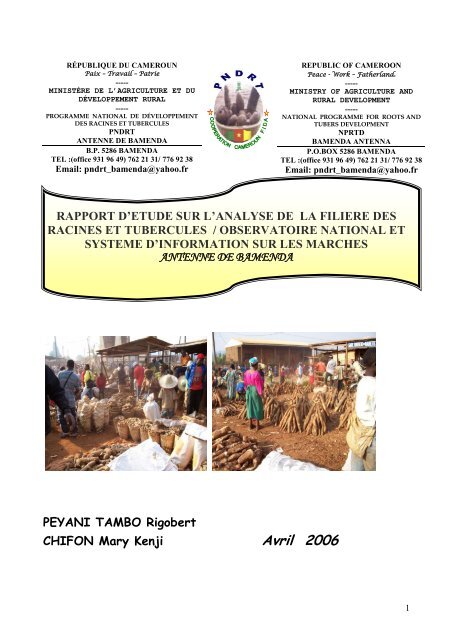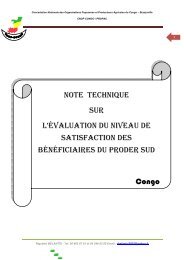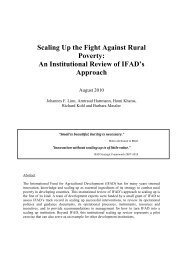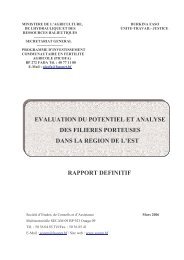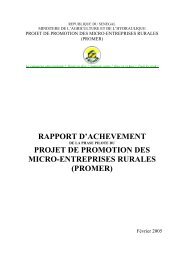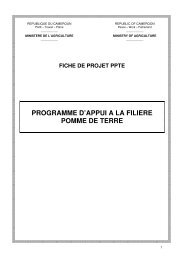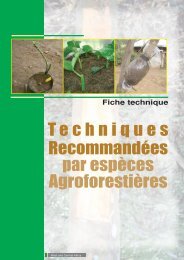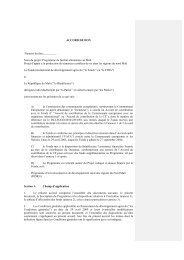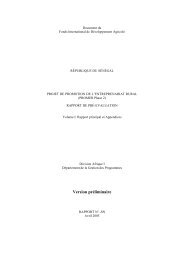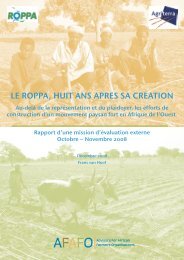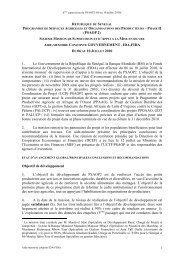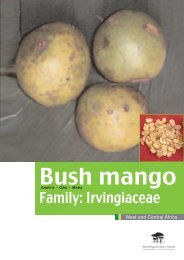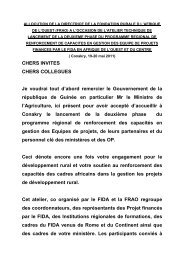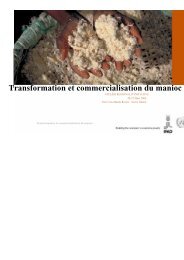Rapport d'étude sur l'analyse de la filière des racines et ... - FIDAfrique
Rapport d'étude sur l'analyse de la filière des racines et ... - FIDAfrique
Rapport d'étude sur l'analyse de la filière des racines et ... - FIDAfrique
You also want an ePaper? Increase the reach of your titles
YUMPU automatically turns print PDFs into web optimized ePapers that Google loves.
RÉPUBLIQUE DU CAMEROUN<br />
Paix – Travail – Patrie<br />
-----<br />
MINISTÈRE DE L’AGRICULTURE ET DU<br />
DÉVELOPPEMENT RURAL<br />
-----<br />
PROGRAMME NATIONAL DE DÉVELOPPEMENT<br />
DES RACINES ET TUBERCULES<br />
PNDRT<br />
ANTENNE DE BAMENDA<br />
B.P. 5286 BAMENDA<br />
TEL :(office 931 96 49) 762 21 31/ 776 92 38<br />
Email: pndrt_bamenda@yahoo.fr<br />
RAPPORT D’ETUDE SUR L’ANALYSE DE LA FILIERE DES<br />
RACINES ET TUBERCULES / OBSERVATOIRE NATIONAL ET<br />
SYSTEME D’INFORMATION SUR LES MARCHES<br />
ANTENNE DE BAMENDA<br />
PEYANI TAMBO Rigobert<br />
CHIFON Mary Kenji Avril 2006<br />
REPUBLIC OF CAMEROON<br />
Peace - Work – Father<strong>la</strong>nd.<br />
-----<br />
MINISTRY OF AGRICULTURE AND<br />
RURAL DEVELOPMENT<br />
-----<br />
NATIONAL PROGRAMME FOR ROOTS AND<br />
TUBERS DEVELOPMENT<br />
NPRTD<br />
BAMENDA ANTENNA<br />
P.O.BOX 5286 BAMENDA<br />
TEL :(office 931 96 49) 762 21 31/ 776 92 38<br />
Email: pndrt_bamenda@yahoo.fr<br />
1
TABLE DE MATIERES<br />
i. Liste <strong>de</strong>s abréviations ----------------------------------------------------------------<br />
1. Introduction------------------------------------------------------------------------------ 1<br />
Objectif Global---------------------------------------------------------------------------- 1<br />
Objectif Spécifiques -------------------------------------------------------------------- 1<br />
2. Méthodologie-------------------------------------------------------------------------- 2<br />
3. RESULTATS OBTENUS------------------------------------------------------- 3<br />
3.1 Généralités---------------------------------------------------------------------------- 3<br />
3.1.1 L’importance <strong>de</strong>s cultures------------------------------------ ------------------- 3<br />
3.1.2 Production <strong>de</strong>s <strong>racines</strong> <strong>et</strong> tubercules --------------------------------------- 5<br />
3.1.3 Valeurs marchan<strong>de</strong>s les <strong>racines</strong> <strong>et</strong> tubercules --------------------------- 6<br />
3.2 Circuit <strong>de</strong> Commercialisation <strong>et</strong> analyse <strong>de</strong> <strong>la</strong> <strong>filière</strong>--------------<br />
10<br />
3.2.1 Intervention Publiques -----------------------------------------------------------10<br />
3.2.2 Intervention Publiques-------------------------------------------------------- 11<br />
3.2.2.1. Les structures d’encadrements ----------------------------------------<br />
12<br />
3.2.2.2. Les producteurs / transformateurs ----------------------------------- 13<br />
3.2.2.3. Les Commerçants ------------------------------------------------------------ 14<br />
3.2.2.4. Les transporteurs ------------------------------------------------------------ 16<br />
3.2.3. Analyse <strong>de</strong> l’environnement interne <strong>et</strong> externe ------------------- 20<br />
2
3.2.3.1 Type <strong>de</strong> marchés <strong>et</strong> système <strong>de</strong> commercialisation -------------- 21<br />
3.2.3.2 Destination <strong>de</strong>s produits----------------------------------------------------- 22<br />
3.2.3.3 Mécanisme <strong>de</strong> fixation <strong>de</strong>s prix ------------------------------------------- 25<br />
3.2.4 Nombre <strong>de</strong> produits <strong>et</strong> leurs variétés------------------------------- 27<br />
3.2.5 Type d’acteurs <strong>et</strong> marchés ---------------------------------- ----- 28<br />
3.2.5.1 Les Marchés --------------------------------------------------------------- 28<br />
3.2.5.2 Les acteurs ----------------------------------------------------------------------- 29<br />
4. DIFFICULTES RENCONTREES----------------------------------------------- 31<br />
5. RECOMMANDATION : ----------------------------------------------------------- 31<br />
6. CONCLUSION------------------------------------------------------------------------- 32<br />
7. Bibliographie--------------------------------------------------------------------------- 33<br />
8. ANNEXES ------------------------------------------------------------------------------38<br />
8.1. Annexe 1 : carte <strong>de</strong> L’antenne ----------------------------------------------38<br />
8.2 Annexe 2 : acteurs rencontrés <strong>et</strong> contacts-------------------------------40<br />
8.3 Annexe 3 : check liste ------------------------------------------------------------- 43<br />
8.4 Annexe 4 : rapports d’étape-----------------------------------------------------45<br />
3
LISTE DES ABBREVIATIONS /ACRONYME<br />
PNDRT : Programme National <strong>de</strong> Développement <strong>de</strong>s Racines <strong>et</strong><br />
Tubercule<br />
MINADER : Ministère <strong>de</strong> L’Agriculture <strong>et</strong> du Développement Rural<br />
BIPFU : Bui Irish Potatoes Farmers Union<br />
NOWEFOR: North West Farmers<br />
MIDENO : North West Development Authority<br />
SNV : Organisme Néalendaise <strong>de</strong> Développement<br />
CIPCRE : Cercle International pour <strong>la</strong> Promotion <strong>de</strong> <strong>la</strong> Création<br />
GIC: Groupe d’initiative Commune<br />
IRAD : Institut <strong>de</strong> Recherche Agricole pour le Développement<br />
O P : Organisation Paysanne<br />
PNVRA : Programme National <strong>de</strong> Vulgarisation Agricole<br />
SAILD : Service d’Appui a Initiative Local Développement<br />
ONG : Organisation Non Gouvernemental<br />
PRTC : Presbyterian Rural Training Centre<br />
FAO : Organisation Mondial pour l’agriculture<br />
R&T : Racines <strong>et</strong> Tubercules<br />
CA : Chef d’Antenne<br />
IAP : Ingénieur Agronome Polyvalent<br />
4
INRODUCTION<br />
Dans le cadre <strong>de</strong> <strong>la</strong> mise en p<strong>la</strong>ce <strong>de</strong> ces activités, le PNDRT antenne <strong>de</strong><br />
Bamenda a mené du 21 Mars au 7 Avril 2006 une enquête <strong>sur</strong> <strong>la</strong> mise en<br />
p<strong>la</strong>ce du système d’information <strong>sur</strong> les marchés <strong>et</strong> l’observatoire national<br />
<strong>de</strong>s <strong>racines</strong> <strong>et</strong> tubercules. Les objectifs <strong>de</strong> l’étu<strong>de</strong> sont :<br />
a) Objectif global<br />
Analyse <strong>de</strong> <strong>la</strong> situation actuelle <strong>de</strong> <strong>la</strong> <strong>filière</strong> <strong>et</strong> du système <strong>de</strong><br />
commercialisation <strong>de</strong>s <strong>racines</strong> <strong>et</strong> tubercules.<br />
b) Objectifs spécifiques<br />
I<strong>de</strong>ntifier les différents acteurs <strong>de</strong> <strong>la</strong> <strong>filière</strong> <strong>de</strong>s R&T dans notre<br />
antenne <strong>et</strong> les types <strong>de</strong> marchés à prendre en compte à chaque<br />
sta<strong>de</strong> <strong>de</strong> l’évolution <strong>de</strong> l’Observatoire ;<br />
Evaluer le potentiel <strong>de</strong> chaque opérateur <strong>et</strong> son <strong>de</strong>gré d’implication<br />
dans le circuit <strong>de</strong> commercialisation ;<br />
Connaître comment s’établissent les prix à chaque maillon <strong>de</strong> <strong>la</strong><br />
chaîne, <strong>et</strong> déterminer les qualités <strong>et</strong> les quantités qui font l’obj<strong>et</strong> <strong>de</strong><br />
transactions ;<br />
Décrire les types d’informations requises par chacun, puis<br />
déterminer <strong>la</strong> fréquence <strong>et</strong> les canaux <strong>de</strong> communication selon<br />
lesquels les acteurs <strong>de</strong> <strong>la</strong> <strong>filière</strong> désirent recevoir les<br />
5
données commerciales, les résultats <strong>de</strong>s étu<strong>de</strong>s techniques <strong>et</strong><br />
autres statistiques agricoles ;<br />
2. METHODOLOGIQUE<br />
Les techniques suivantes ont été utilisées pour collecter les données<br />
Revue <strong>de</strong> <strong>la</strong> littérature<br />
Entr<strong>et</strong>ien (interview semi structurée) avec les acteurs <strong>de</strong> <strong>la</strong> <strong>filière</strong><br />
observation (<strong>de</strong>scente <strong>sur</strong> le terrain)<br />
Le calendrier <strong>de</strong> <strong>de</strong>scente <strong>sur</strong> le terrain étaient comme suit :<br />
Date Lieu Responsable<br />
21/ 03/06 Bamenda<br />
Mbouda<br />
22/03 / 06 Bamenda<br />
Foumban, Koutapa,<br />
Foumbot<br />
23/03/06 Bafoussam <strong>et</strong> ses<br />
environs<br />
24-25/03/ 06 Menoua <strong>et</strong> ses<br />
environs<br />
CA<br />
IAP<br />
CA<br />
IAP<br />
CA <strong>et</strong> IAP<br />
CA <strong>et</strong> IAP<br />
Santa CA<br />
25/ 03/ 06<br />
IAP<br />
26-28/03/06 Kumbo <strong>et</strong> Oku CA<br />
30 /03-1 er /04/06 Bafoussam –Banjoun-<br />
Baham<br />
IAP<br />
03/04/06 Batibo <strong>et</strong> Mbengwi IAP<br />
04-05/04/06 N<strong>de</strong> CA<br />
IAP<br />
06-07/04/06 Haut Nkam CA<br />
IAP<br />
6
3. RESULTATS OBTENUS<br />
3.1 Généralités<br />
3.1.1 L’importance <strong>de</strong>s spécu<strong>la</strong>tions <strong>et</strong> principaux marchés par bassin<br />
Bassins Spécu<strong>la</strong>tions dominantes Poids économique Principaux marchés<br />
du bassin<br />
N<strong>de</strong> Macabo/taro, manioc<br />
Igname, pomme <strong>de</strong> terre<br />
Foumbot Manioc ; Macabo/taro<br />
Igname ; patate douce<br />
Foumban Manioc ; Macabo/taro<br />
Igname ; patate douce<br />
Mifi Manioc ; Macabo/taro<br />
Igname ; patate douce,<br />
pomme <strong>de</strong> terre<br />
Bamboutos Manioc ; Macabo/taro<br />
Igname ; patate douce,<br />
pomme <strong>de</strong> terre<br />
Haut Nkam Manioc ; Macabo/taro<br />
Igname ; patate douce,<br />
pomme <strong>de</strong> terre<br />
1 60 % consommé dans les foyers<br />
2 Faiblement produite, grand potentiel<br />
3 Principal nourriture <strong>de</strong> <strong>la</strong> région<br />
Manioc (frais, fufu 1 , gari)<br />
Pomme <strong>de</strong> terre 2<br />
kamna<br />
Macabo/taro; patate Foumbot , Kouptamo<br />
douce, manioc, igname<br />
patate douce<br />
Koutaba, Foumban<br />
manioc<br />
Manioc, pomme <strong>de</strong> terre Bafoussam (A <strong>et</strong> B)<br />
Bangou<br />
Pomme <strong>de</strong> terre, manioc,<br />
macabo /taro<br />
igname<br />
patate douce<br />
Macabo/taro ; manioc<br />
(fufu 3 , coss<strong>et</strong>te, gari)<br />
Mbouda, Galim,<br />
Ba<strong>la</strong>chi-Bangan,<br />
Babajou<br />
Kekem( Tchouafé)<br />
Mbewei, Banja, Banwa<br />
Mwebo<br />
7
Menoua Manioc ; Macabo/taro<br />
Igname ; patate douce,<br />
pomme <strong>de</strong> terre<br />
Boyo Manioc ; Macabo/taro<br />
Igname ; patate douce<br />
Bui<br />
Manioc ; Macabo/taro<br />
Igname ; patate douce,<br />
pomme <strong>de</strong> terre<br />
Donga Mantung Manioc ; Macabo/taro<br />
Igname ; patate douce,<br />
pomme <strong>de</strong> terre<br />
Menchum Manioc ; Macabo/taro<br />
Igname ;<br />
Bamenda Manioc, macabo/taro ;<br />
igname<br />
Pomme <strong>de</strong> terre<br />
Macabo/taro<br />
Djuititsa - Nkongle,<br />
Manioc; macabo/taro Belo, Fundong<br />
Pomme <strong>de</strong> terre Kumbo, Jakiri<br />
Igname, pomme <strong>de</strong> terre,<br />
manioc (garri)<br />
Macabo/taro, Manioc<br />
(garri)<br />
Manioc, macabo/taro<br />
(Water fufu, garri)<br />
Misaje<br />
Sabogari<br />
Benakuma<br />
Befang, Weh<br />
Bamenda (Main<br />
mark<strong>et</strong> and food<br />
mark<strong>et</strong>, Bali)<br />
Santa Pomme <strong>de</strong> terre Pomme <strong>de</strong> terre Santa -Pinyin<br />
Momo Monioc ; macabo/taro<br />
igname<br />
Manioc Guzang, Tat<br />
Ngok<strong>et</strong>undjia<br />
Source : enquêt<br />
Manioc ; Macabo/taro<br />
Igname ; patate douce,<br />
Manioc ; macabo/taro Babessi, Bamessing,<br />
Babungo.<br />
8
3.1.2 Production <strong>de</strong>s <strong>racines</strong> <strong>et</strong> tubercules dans l’antenne<br />
Comme l’indique le tableau ci-<strong>de</strong>ssous <strong>la</strong> production total <strong>de</strong>s R&T en<br />
2005 est estimée à environ 1 623768 tonnes selon les rapports <strong>de</strong>s<br />
services <strong>de</strong>s délégations provinciales <strong>de</strong> l’agriculture <strong>de</strong> l’Ouest <strong>et</strong> du<br />
Nord Ouest. ; L’étu<strong>de</strong> <strong>de</strong> base n’ayant estimé que les superficies<br />
Spécu<strong>la</strong>-<br />
Production annuelle en tonnes<br />
tions 2000 2001 2002 2003 2004 2005<br />
Manioc 270172 260461 260940 493392 542731 597004<br />
Macabo/<br />
taro<br />
cultivées.<br />
91341 130602 145770 333 362 356697 381665<br />
Patate 56204 50942 56870 64129 68618<br />
Pomme <strong>de</strong><br />
terre<br />
Selon nos estimations (Avril 2006) ces chiffres représentent<br />
environ le quart (¼) <strong>de</strong> <strong>la</strong> production exacte. Ainsi <strong>la</strong> production<br />
totale pourrait s’estimer à environ 6 495 072 tonnes, toutes les<br />
spécu<strong>la</strong>tions confondues.<br />
S’agissant <strong>de</strong>s produits transformés, <strong>la</strong> production annuelle <strong>de</strong>s<br />
produits transformés <strong>de</strong>s <strong>racines</strong> <strong>et</strong> tubercules est estimé à environ<br />
2. 600.000 tonnes reparties comme suivent en valeur re<strong>la</strong>tive.<br />
gari : 25% soit 650 000 tonnes<br />
waterfufu : 30% soit 780 000 tonnes<br />
73421<br />
250131 255686 252953 261686 265240 269806<br />
Igname 278842 284084 270970 297663 295208 301872<br />
9
Coss<strong>et</strong>te 4 : 26% soit 676 000 tonnes<br />
Farine : 8 % soit 325 000 tonnes<br />
(Fufu) Koumkoum : 18% soit 468000 tonnes (PNDRT 2005)<br />
3.1.3 Valeurs marchan<strong>de</strong>s <strong>de</strong>s <strong>racines</strong> <strong>et</strong> tubercules<br />
Les <strong>racines</strong> <strong>et</strong> tubercules en <strong>de</strong>ux mots, c’est :<br />
6 495 072 tonnes <strong>de</strong> produits frais estimés à environ<br />
51 960 576 000 f CFA : si <strong>la</strong> tonne est vendue à 8000<br />
francs (PNDRT, Avril 2006)<br />
Il est cependant difficile d’estimer les quantités autoconsommées<br />
par les producteurs <strong>et</strong> les transformateurs. Néanmoins, le tableau ci-<br />
<strong>de</strong>ssous nous donne les spécu<strong>la</strong>tions les plus autoconsommées par<br />
bassin <strong>et</strong> l’estimation <strong>de</strong>s quantités <strong>de</strong>s produits vendus dans<br />
certains <strong>de</strong>s marchés <strong>de</strong>s bassins<br />
4 C<strong>et</strong>te quantité comprend aussi les coss<strong>et</strong>tes <strong>de</strong> patate<br />
10
Bassins <strong>et</strong><br />
caractéristiques<br />
N<strong>de</strong> (zone<br />
rurale à faible<br />
production<br />
Foumbot (zone<br />
rurael <strong>de</strong> très<br />
gran<strong>de</strong>s<br />
productions)<br />
Foumban (zone<br />
rurale <strong>de</strong> très<br />
gran<strong>de</strong>s<br />
productions)<br />
Mifi (zone<br />
urbaine)<br />
Bamboutos<br />
(zone rurale)<br />
Spécu<strong>la</strong>tions dominantes Produits les plus<br />
auto consommés<br />
auto<br />
Macabo/taro, manioc<br />
Igname, pomme <strong>de</strong> terre<br />
Manioc ; Macabo/taro<br />
Igname ; patate douce<br />
Manioc ; Macabo/taro<br />
Igname ; patate douce<br />
Manioc ; Macabo/taro<br />
Igname ; patate douce, pomme<br />
<strong>de</strong> terre<br />
Manioc ; Macabo/taro<br />
Igname ; patate douce, pomme<br />
Manioc : fufu<br />
(kumkum)<br />
Manioc (1%) en<br />
coss<strong>et</strong>tes,<br />
igname<br />
Manioc (1%) en<br />
coss<strong>et</strong>tes,<br />
igname<br />
Principaux<br />
marchés du<br />
bassin<br />
kamna inconnue<br />
Foumbot,<br />
Kouptamo<br />
Manioc (Fufu) Bafoussam (A <strong>et</strong><br />
B)<br />
Bangou<br />
Pomme <strong>de</strong> terre,<br />
macabo /taro<br />
Estimation <strong>de</strong>s quantités 5<br />
Vendues par spécu<strong>la</strong>tion 6<br />
Patate douce (Juin- Janvier) :<br />
environ 60 tonnes par semaine<br />
Cos<strong>et</strong>te <strong>de</strong> manioc (octobre-<br />
Mars) : 30tonnes par semaine<br />
Macabo –taro : (Octobre- Mars) :<br />
35 tonnes<br />
Koutaba, Foumban Patate douce (Juin- Janvier) :<br />
environ 90 tonnes par semaine<br />
Cos<strong>et</strong>te <strong>de</strong> manioc (octobre-<br />
Mars) : 35 tonnes par semaine<br />
Macabo –taro : (Octobre- Mars) :<br />
20 tonnes<br />
Mbouda, Galim,<br />
Ba<strong>la</strong>chi-Bangan,<br />
Pomme ach<strong>et</strong>ée : 12 tonnes par<br />
semaines<br />
Pomme <strong>de</strong> terre (juill<strong>et</strong> -avril) :<br />
90 tonnes par semaines<br />
5 Pério<strong>de</strong> optimum <strong>de</strong> production : patate : Juin –Janvier, manioc juill<strong>et</strong> – Mars, coss<strong>et</strong>tes manioc : Octobre- Mars, Pomme <strong>de</strong> terre : juill<strong>et</strong> –<br />
avril, macabo/taro : Octobre avril, Igname : Novembre- Janvier<br />
6 Informations obtenues auprès <strong>de</strong>s transporteurs <strong>de</strong>s camions 7 à 20 tonnes ou / agents <strong>de</strong> transport<br />
11
<strong>de</strong> terre igname Babajou Macabo taro : 35 tonnes<br />
Manioc, fufu <strong>et</strong> gari<br />
Coss<strong>et</strong>te : 10 tonnes/semaines<br />
Haut Nkam Manioc ; Macabo/taro<br />
Igname ; patate douce, pomme<br />
<strong>de</strong> terre<br />
Menoua Manioc ; Macabo/taro<br />
Igname ; patate douce, pomme<br />
<strong>de</strong> terre<br />
Boyo Manioc ; Macabo/taro<br />
Igname ; patate douce<br />
Bui<br />
Manioc ; Macabo/taro<br />
Igname ; patate douce, pomme<br />
<strong>de</strong> terre<br />
Donga Mantung Manioc ; Macabo/taro<br />
Igname ; patate douce, pomme<br />
<strong>de</strong> terre<br />
Mentchum Manioc ; Macabo/taro<br />
Igname ;<br />
patate douce<br />
Macabo/taro ;<br />
manioc (fufu)<br />
Pomme <strong>de</strong> terre<br />
Manioc;<br />
macabo/taro<br />
Kekem (Tchouafé)<br />
Mbewei, Banja,<br />
Banwa<br />
Mwebo<br />
Djuititsa -<br />
Nkongle, Fongo<br />
Tongo, Dshang<br />
Belo, Fundong,<br />
Njinikom<br />
Kekem (Tchouafé) (patate) :25t par<br />
semaine<br />
Les informations <strong>de</strong>s autres<br />
marchés ne sont pas connues,<br />
Néanmoins le marché <strong>de</strong> Banja est<br />
un point vente <strong>de</strong>s coss<strong>et</strong>tes <strong>de</strong><br />
manioc<br />
Pomme <strong>de</strong> terre : 24 tonnes par<br />
marché<br />
Macabo/taro : 70t par semaine :<br />
Sept-Dec<br />
Pommes <strong>de</strong> terres :<br />
Pomme <strong>de</strong> terre Kumbo, Jakiri Pommes <strong>de</strong>s terres : Kumbo : Juin –<br />
Oct 500t par semaine<br />
Igname, pomme<br />
<strong>de</strong> terre, manioc<br />
Macabo/taro<br />
Misaje<br />
Sabogari<br />
Benakuma<br />
Befang<br />
Weh<br />
Garri :<br />
Ignames :<br />
Pommes <strong>de</strong> terres<br />
Garri : 150t par semaine<br />
Macabo/taro : 60t par semaine<br />
Patate douce : Inconnu<br />
Bamenda Manioc, macabo/taro ; igname Manioc, Bamenda (Food Bamenda: marché <strong>de</strong> Consommation.<br />
12
(marché urbain) (Waterfufu,<br />
gari)<br />
macabo/taro<br />
mark<strong>et</strong> and main<br />
mark<strong>et</strong>, Bali)<br />
Santa Pomme <strong>de</strong> terre Pomme <strong>de</strong> terre Santa , Pinyin<br />
Momo Monioc ; macabo/taro<br />
igname<br />
Ngok<strong>et</strong>undjia Manioc ; Macabo/taro<br />
Igname ; patate douce,<br />
Gari. Inconnue<br />
Waterfufu : Juin-Sept 25 t par<br />
semaine<br />
Manioc Guzang, Tat Garri : Inconnue<br />
Igname : Inconnue<br />
Manioc ;<br />
macabo/taro<br />
Babessi,<br />
Bamessing,<br />
Babungo<br />
Garri : Inconnue<br />
Macabo/taro<br />
13
3.2 Circuit <strong>de</strong> commercialisation <strong>et</strong> analyse <strong>de</strong> <strong>la</strong> <strong>filière</strong><br />
3.2.1 Intervenants publiques impliqués dans <strong>la</strong> <strong>filière</strong><br />
Quelques services publics interviennent <strong>de</strong> manières sporadiques<br />
dans <strong>la</strong> promotion <strong>de</strong>s marchés <strong>et</strong> <strong>la</strong> commercialisation <strong>de</strong>s <strong>racines</strong> <strong>et</strong><br />
tubercules. On peut les citer au bout <strong>de</strong>s doigts :<br />
Le MINADER : à travers ces services déconcentrés (PNVRA)<br />
organise <strong>et</strong> forme les Organisations paysannes aux ventes<br />
groupées <strong>de</strong>s produits <strong>et</strong> <strong>la</strong> recherche <strong>de</strong>s débauchés, <strong>sur</strong>tout<br />
comment tenir un compte exploitation<br />
Les services <strong>de</strong>s statistiques agricoles <strong>et</strong> le SNAR du<br />
MINADER : donnent les statistiques agricoles <strong>sur</strong> <strong>la</strong> production,<br />
<strong>la</strong> disponibilité <strong>de</strong>s produits dans les marchés <strong>et</strong> <strong>la</strong> fluctuation<br />
<strong>de</strong>s prix dans certains marchés<br />
Les mairies : quelques maries interviennent dans l’organisation<br />
<strong>de</strong>s marchés <strong>de</strong> R&T. Il s’agit <strong>de</strong>s maries <strong>de</strong> :<br />
a. Kumbo : afin <strong>de</strong> limiter les pertes post récolte, <strong>la</strong><br />
marie est en train <strong>de</strong> m<strong>et</strong>tre <strong>sur</strong> pieds en partenariat<br />
avec <strong>la</strong> SNV, IRAD, BIPFU <strong>et</strong> ACR Group <strong>de</strong>s Etats-<br />
Unis d’Amérique un proj<strong>et</strong> <strong>de</strong> transformation pomme <strong>de</strong><br />
terre <strong>et</strong> vente <strong>de</strong>s chips au Cameroun <strong>et</strong> à l’extérieur.<br />
14
. Batibo : afin <strong>de</strong> mieux collecter les taxes, c<strong>et</strong>te marie<br />
organise, elle-même les ventes contrôlées <strong>de</strong>s produits<br />
<strong>de</strong> transformation du manioc<br />
c. Les autres mairies n’ont aucune action directe dans <strong>la</strong><br />
commercialisation <strong>de</strong>s Produits <strong>de</strong> R&T en <strong>de</strong>hors <strong>de</strong><br />
leur rôle <strong>de</strong> collecteurs <strong>de</strong> taxe.<br />
Les chambres d’agriculture <strong>et</strong> <strong>de</strong> commerce :<br />
Aucune présence effective observée <strong>sur</strong> le terrain, même les<br />
informations secondaires n’existent pas dans leurs documentations.<br />
MIDENO : <strong>la</strong> mission <strong>de</strong> développement <strong>de</strong> <strong>la</strong> province du Nord<br />
Ouest est une structure d’encadrement à <strong>la</strong> production <strong>et</strong> à <strong>la</strong><br />
commercialisation<br />
3.2.2 Intervenants privés impliqués dans <strong>la</strong> <strong>filière</strong><br />
Dans le secteur privé il existe plusieurs intervenants : les ONG,<br />
organisations professionnelles <strong>et</strong> les organisations paysannes, les<br />
personnes opérants individuellement. Ces intervenants peuvent être<br />
divisés en catégories suivantes :<br />
Les structures d’encadrement : les ONG <strong>et</strong> organisations<br />
interprofessionnelles<br />
Les producteurs/ transformateurs<br />
Les commerçants (bayam sel<strong>la</strong>m, (détail<strong>la</strong>nts, semi-grossiste)<br />
intermédiaire, grossiste, exportateurs)<br />
15
Les transporteurs :(chauffeurs, intermédiaires, les chargeurs,<br />
les propriétaires)<br />
3.2.2.1 Les structures d’encadrements<br />
Nous avons vu :<br />
Le SAILD : ai<strong>de</strong> les p<strong>la</strong>nteurs à <strong>la</strong> production (formation,<br />
fournis les semences <strong>de</strong> bonnes qualités), commercialisation<br />
(recherche les débauchés pour ces OP, négocie le prix <strong>de</strong>s<br />
produits, former les OP aux techniques <strong>de</strong> recherche <strong>et</strong><br />
négociation <strong>de</strong>s prix). En 2004 le SAILD a mis en contact<br />
certaines organisations professionnelles (NOWEFOR) à vendre<br />
les pommes <strong>de</strong> terre à Doua<strong>la</strong>.<br />
SNV : renforce les capacités <strong>de</strong> BIPFU en matière <strong>de</strong><br />
structuration, <strong>de</strong> commercialisation <strong>de</strong>s pommes <strong>de</strong> terre <strong>et</strong><br />
transformation <strong>de</strong>s pommes <strong>de</strong> terre en chips.<br />
Le CIPCRE : organise chaque année une foire <strong>de</strong>s pommes <strong>de</strong><br />
terre dans le bassin <strong>de</strong>s Bamboutos (Bangan), Bui (Ngondzen)<br />
c<strong>et</strong>te foire m<strong>et</strong> en contact producteurs, ach<strong>et</strong>eurs <strong>et</strong> ven<strong>de</strong>urs<br />
<strong>de</strong> pomme <strong>de</strong> terre, parfois les contrats sont signés entre<br />
producteurs <strong>et</strong> ven<strong>de</strong>urs <strong>de</strong> pomme terre<br />
16
Il existe beaucoup d’autres ONG que nous n’avons pas pu<br />
i<strong>de</strong>ntifiées mais qui interviennent dans <strong>la</strong> commercialisation <strong>de</strong>s<br />
produits <strong>de</strong> R&T dans l’antenne.<br />
Organisations interprofessionnelles : dans certains bassins <strong>de</strong><br />
l’antenne, on rencontre <strong>de</strong>s Organisations professionnelles qui<br />
encadrent les Paysans dans <strong>la</strong> production <strong>et</strong> <strong>la</strong> commercialisation<br />
<strong>de</strong>s produits c’est le cas <strong>de</strong> BIPFU (production <strong>et</strong><br />
commercialisation <strong>de</strong>s Pommes <strong>de</strong> terre dans le bassin du Bui)<br />
<strong>et</strong> NOWEFOR commercialisation <strong>de</strong>s Ignames dans le bassin <strong>de</strong><br />
<strong>la</strong> Momo).les pommes <strong>de</strong> terres dans le Bui <strong>et</strong> Donga/Mantung.<br />
Pour ces <strong>de</strong>ux structures les quantités vendues n’ont pas pu être<br />
estimées (voir rapports d’étape).<br />
3.2.2.2 Les producteurs/ transformateurs<br />
Ils opèrent soit individuellement, soit au sein <strong>de</strong>s organisations<br />
paysannes. Ils sont à <strong>la</strong> base <strong>de</strong> <strong>la</strong> commercialisation <strong>de</strong>s R&T car<br />
sans eux les produits n’existeraient pas. C’est l’acteur incontournable<br />
bien que inconsidéré par les acteurs pour les raisons que nous<br />
expliquerons au point 3.2.3. Les producteurs sont regroupés en GIC,<br />
union <strong>de</strong>s GIC <strong>et</strong> fédérations <strong>de</strong>s GIC. Malgré c<strong>et</strong>te organisation <strong>de</strong>s<br />
producteurs, ces organisations n’arrivent pas à quantifier les produits<br />
17
vendus. Cependant ces producteurs réussissent parfois à fixer les<br />
prix <strong>de</strong> leurs produits c’est le cas <strong>de</strong>s <strong>de</strong> l’union <strong>de</strong>s producteurs <strong>de</strong><br />
pomme <strong>de</strong> terre <strong>de</strong> Fongo Tongo, union départemental <strong>de</strong>s GIC <strong>de</strong> <strong>la</strong><br />
Menoua <strong>et</strong> l’union <strong>de</strong>s GIC <strong>de</strong> Djuititsa (prix variant <strong>de</strong> 1800 f à<br />
2500 f selon <strong>la</strong> saison pour le seau <strong>de</strong> 15 litres). Il faudrait noter que<br />
ses organisations ne sont qu’en situation d’apprentissage dans le<br />
domaine <strong>de</strong> commercialisation.<br />
3.2.2.3 Les commerçants (bayem /sel<strong>la</strong>m, intermédiaires,<br />
grossistes, détail<strong>la</strong>nts, exportateurs)<br />
Ces commerçants as<strong>sur</strong>ent <strong>la</strong> distribution <strong>de</strong>s produits <strong>de</strong>s zones <strong>de</strong><br />
production vers les zones <strong>de</strong> consommation. Chaque type <strong>de</strong><br />
commerçants joue un rôle essentiel dans <strong>la</strong> chaîne <strong>de</strong> distribution <strong>et</strong><br />
commercialisation <strong>de</strong>s produits.<br />
Les bayem sel<strong>la</strong>m sont visibles dans les p<strong>et</strong>its marchés <strong>de</strong><br />
brousses <strong>et</strong> parfois urbains <strong>et</strong> à toutes les saisons, c’est les<br />
collecteurs <strong>de</strong>s produits <strong>de</strong>s zones productions vers les points<br />
ou marchés <strong>de</strong> collecte. Ils ne possè<strong>de</strong>nt pas <strong>de</strong> gros fonds <strong>de</strong><br />
commerce (moins <strong>de</strong> 100 000 Frs), mais ont <strong>de</strong>s re<strong>la</strong>tions<br />
particulières avec les producteurs. Ils sont incontournables dans<br />
<strong>la</strong> collecte <strong>et</strong> distribution <strong>de</strong>s produits.<br />
Les intermédiaires : ce sont les agents <strong>de</strong>s grossistes <strong>et</strong><br />
parfois <strong>de</strong>s exportateurs, ils n’ont aucun fonds <strong>de</strong> commerce. Ce<br />
18
sont <strong>de</strong>s négociateurs <strong>et</strong> informateurs. Ils sont très redoutés<br />
par les bayem sel<strong>la</strong>m d’une part car pour ces <strong>de</strong>rniers ils<br />
déstabilisent le marché (augmentation <strong>de</strong>s prix d’achat <strong>de</strong>s<br />
produits) <strong>et</strong> par les producteurs car ils ach<strong>et</strong>ant les produits<br />
très moins chers <strong>et</strong> d’autre part car ils empêchent les grossistes<br />
<strong>et</strong> exportateurs d’être en contact direct avec les producteurs<br />
Les détail<strong>la</strong>nts : c’est le <strong>de</strong>rnier maillon <strong>de</strong> <strong>la</strong> chaîne, ils<br />
ven<strong>de</strong>nt leurs produits directement aux consommateurs<br />
Grossistes <strong>et</strong> exportateurs : Ils sont rarement vus dans les<br />
marchés, ils utilisent beaucoup plus les intermédiaires. Ces sont<br />
les acteurs les plus discr<strong>et</strong>s <strong>de</strong> <strong>la</strong> <strong>filière</strong>. Ils n’acceptent pas<br />
donner leurs contacts,<br />
Le tableau ci-<strong>de</strong>ssous indique les interactions entre les différents<br />
commerçants.<br />
19
Bayem<br />
Salem<br />
Détail<strong>la</strong>nts<br />
Zone <strong>de</strong> Production<br />
3.2.2.4 les transporteurs<br />
Dans les bassins on distingue :<br />
Les chauffeurs<br />
Les intermédiaires<br />
Les chargeurs<br />
Grossistes<br />
Intermédiai<br />
res<br />
Exportateur<br />
s<br />
20
Les propriétaires <strong>de</strong> voitures/camions<br />
Les chauffeurs <strong>de</strong> camion (au <strong>de</strong> là <strong>de</strong> 5 tonnes) : dans les zones où<br />
l’on ne trouve pas les intermédiaires ils sillonnent les vil<strong>la</strong>ges <strong>et</strong><br />
marchés comme tous les autres taxis. C’est <strong>la</strong> loi <strong>de</strong> l’offre <strong>et</strong> <strong>la</strong><br />
<strong>de</strong>man<strong>de</strong> qui fixe le prix <strong>de</strong> transport <strong>de</strong> <strong>la</strong> marchandise.<br />
Les taxis brousses : ces sont les véhicules déjà amortis, ils<br />
servent <strong>de</strong> liaison entre les vil<strong>la</strong>ges <strong>et</strong> les routes « praticables » ou<br />
vil<strong>la</strong>ges <strong>et</strong> les grands marchés locaux ; nous c<strong>la</strong>ssons aussi les<br />
véhicules tout terrain dans c<strong>et</strong>te catégorie.<br />
Les intermédiaires : ce sont <strong>de</strong>s personnes ne possédant aucun<br />
véhicule ; pourtant ils sont incontournables dans le transport <strong>de</strong>s<br />
marchandises ; Ils servent <strong>de</strong> liaison (transitionnaires) entre le<br />
chauffeur <strong>et</strong> le commerçant. C’est l’intermédiaire qui sait où se<br />
trouvent les produits à transporter, négocie les prix <strong>de</strong> transport,<br />
chercher le transporteur, charge le véhicule, paie le chauffeur, lui<br />
donne le bor<strong>de</strong>reau <strong>de</strong>s marchandises, paie le déchargement à<br />
travers ses agents situés dans les différents points d’arrêts<br />
(<strong>de</strong>stinations). Dans certains marchés ils ont le monopole <strong>de</strong>s<br />
chargements (Bafoussam, Foumbot, Koutaba, Kumbo, Kouptamo<br />
<strong>et</strong>c.) ni le chauffeur ni le commerçants <strong>et</strong> même le propriétaire ne<br />
peut avoir accès au chargement sans son accord. C’est le tout<br />
21
puissant <strong>de</strong> <strong>la</strong> <strong>filière</strong> .Ici l’expéditeur n’est pas obligé<br />
d’accompagner son produit. L’intermédiaire est le garant <strong>de</strong> <strong>la</strong><br />
marchandise transportée en cas <strong>de</strong> perte.<br />
Les propriétaires : ils possè<strong>de</strong>nt un ou plusieurs véhicules, ils<br />
exigent <strong>de</strong>s rec<strong>et</strong>tes hebdomadaires ou mensuelles aux chauffeurs.<br />
Ils ne sont pas connus par les commerçants. Ils aimeraient intervenir<br />
directement dans <strong>la</strong> <strong>filière</strong> mais ils sont bloqués soit par les<br />
chauffeurs ou bien par les intermédiaires. Le diagramme ci-<strong>de</strong>ssous<br />
indique les interactions dans le domaine <strong>de</strong> transport.<br />
22
Marchés<br />
ruraux<br />
Marchés<br />
urbains<br />
s<br />
Producteurs/ commerçants marchés ruraux<br />
Taxi<br />
brousses<br />
Intermédiaires<br />
NB : les intermédiaires n’existent pas dans tous les marchés, ils<br />
Camions<br />
agissent dans les bassins <strong>de</strong> Foumbot, Foumban, Bafoussam, Bui <strong>et</strong><br />
certains marchés que nous ne maîtrisons pas ici.<br />
23
3.2.3 Analyse <strong>de</strong> l’environnement interne <strong>et</strong> externe <strong>de</strong> <strong>la</strong><br />
<strong>filière</strong> <strong>de</strong>s R&T <strong>et</strong> analyse du système <strong>de</strong> commercialisation<br />
actuel<br />
Ce point ne sera pas traité <strong>de</strong> manière globale, nous allons le<br />
découper par spécu<strong>la</strong>tions ou par type d’acteurs afin <strong>de</strong> mieux<br />
analyser les situations :<br />
3.2.3.1 Au niveau <strong>de</strong>s producteurs<br />
Ils ont <strong>de</strong>ux métho<strong>de</strong>s <strong>de</strong> commercialisation <strong>de</strong> leurs produits :<br />
Le produit est récolté <strong>et</strong> vendu (frais ou transformé) au<br />
marché local ou tout autre marché si le prix du produit y est<br />
alléchant, dans ce cas c’est le producteur qui initie le prix <strong>de</strong><br />
son produit (pomme terre, Macabo/ taro, manioc frais,<br />
igname, patate). La loi <strong>de</strong> l’offre <strong>et</strong> <strong>la</strong> <strong>de</strong>man<strong>de</strong> fixera le prix<br />
final.<br />
Le produit est vendu en champ ; dans ce cas c’est l’ach<strong>et</strong>eur<br />
qui récolte le produit en champ, le calibre. Ici c’est l’ach<strong>et</strong>eur<br />
qui initie le prix <strong>de</strong> <strong>la</strong> marchandise (patate douce dans les<br />
bassins <strong>de</strong> Foumbot <strong>et</strong> Foumban, pomme <strong>de</strong> terre dans les<br />
bassins <strong>de</strong>s Bamboutos). Ici l’ach<strong>et</strong>eur qui tire plus le profit.<br />
24
3.2.3.2 Type <strong>de</strong> marchés <strong>et</strong> système <strong>de</strong> commercialisation<br />
1. Bord Champ<br />
2. Bordure <strong>de</strong>s grands axes routières : Concerne toutes les<br />
spécu<strong>la</strong>tions : orienté vers les voyageurs <strong>et</strong> les produits sont<br />
plus chers que dans les marchés périodiques <strong>de</strong>s vil<strong>la</strong>ges. Les<br />
ven<strong>de</strong>urs sont les bayam/sel<strong>la</strong>m.<br />
3. Marchés périodiques (périodicité <strong>de</strong> 8jours) : ces marchés<br />
ruraux/urbains constituent <strong>de</strong>s points <strong>de</strong> collecte <strong>de</strong>s<br />
produits<br />
4. Marches Urbains<br />
Ach<strong>et</strong>eur récolte lui-même ses<br />
marchandises : manioc <strong>et</strong> patate douce<br />
Producteur récolte <strong>et</strong> vend au champ :<br />
manioc, patate douce, pomme <strong>de</strong> terres,<br />
macabo/taro<br />
Interne (auto consommation): Bamenda (food<br />
and main mark<strong>et</strong>s) Bafoussam (Marchés A <strong>et</strong> B),<br />
Kumbo, Banganté, Bafang, Nkambé<br />
Externe (essentiellement tournés vers<br />
l’extérieur) : Mbouda, Foumbot, Misaje, Kumbo,<br />
Dschang, Sabogari<br />
Extérieurs à l’antenne : Doua<strong>la</strong>, Yaoundé,<br />
Ngaoundéré, Kyosie, Garoua, Maroua<br />
5. Marchés sous régionaux : Gabon, Guinée Equatoriale, Congo<br />
25
3.2.3.3 Destinations <strong>de</strong>s produits<br />
Pomme <strong>de</strong> terre<br />
Provenance<br />
Bangan, Mbouda<br />
Destination<br />
Doua<strong>la</strong> (Marché<br />
sandaga,<br />
Deido, Madagascar,<br />
Bonaberie, Port<br />
autonome)<br />
Kumbo<br />
Ndu<br />
Bafoussam<br />
Santa Djuititsa ,<br />
Fongo<br />
Tongo<br />
Yaoundé<br />
Marchés<br />
frontaliers / <strong>et</strong><br />
sous régionaux<br />
(Congo, Tchad,<br />
Gabon, Guinée<br />
équatorial<br />
26
Patate douce<br />
Provenance Destinations<br />
Marchés nationaux Marchés frontaliers<br />
Koutaba<br />
Foumban<br />
Foumbot<br />
Kekem (marché<br />
Tchouffé)<br />
Doua<strong>la</strong> <strong>et</strong> port<br />
autonome<br />
Yaoundé<br />
Doua<strong>la</strong><br />
Kiosy (Abam Minko)<br />
Gabon<br />
Manioc <strong>et</strong> ses dérivés<br />
Provenance Destinations<br />
Marchés nationaux Marchés<br />
Extérieurs<br />
Mbouda<br />
- manioc frais<br />
- coss<strong>et</strong>te<br />
- farine <strong>de</strong> manioc<br />
Mbengwi, Batibo <strong>et</strong><br />
Mankon<br />
- water fufu <strong>et</strong> Gari<br />
Foumbot, Koutaba,<br />
Foumban<br />
- coss<strong>et</strong>te<br />
Banja :<br />
Farine <strong>et</strong> cos<strong>et</strong>te<br />
fufu<br />
Bali – Bamenda<br />
- Gari<br />
Misaje, Sabongari ,<br />
Mbonso<br />
- Gari<br />
Mbouda<br />
Doua<strong>la</strong><br />
Doua<strong>la</strong><br />
Yaoundé <strong>et</strong> Doua<strong>la</strong>,<br />
Bamenda, Bafoussam<br />
Doua<strong>la</strong>, Bafoussam<br />
Doua<strong>la</strong><br />
Doua<strong>la</strong>, Yaoundé, Bafang<br />
Bamenda, Doua<strong>la</strong><br />
Nkambé, Magba, Kumbo<br />
Gabon, Congo<br />
Gabon<br />
Nigeria<br />
Nigeria<br />
27
Macabo / taro<br />
Provenance Destinations<br />
Marchés nationaux Marchés Extérieurs<br />
Benakuma<br />
Befang<br />
Weh<br />
Oshie, Ngie<br />
Benakuma, Bamenda<br />
Befang, Bamenda<br />
Weh, Bamenda<br />
Bamenda<br />
Kouptamo, Foumbot Bamenda, Doua<strong>la</strong>,<br />
Yaoundé, Bafoussam<br />
Galim Mbouda, Bafoussam,<br />
Doua<strong>la</strong>, Bamenda,<br />
Yaoundé<br />
Guzang Bamenda<br />
Nkambe <strong>et</strong> Environs Kumbo, Bamenda<br />
Igname<br />
Le marché <strong>de</strong>s ignames n’est pas très organisé comme les autres<br />
spécu<strong>la</strong>tions, néanmoins il faudrait noter tous les vil<strong>la</strong>ges produisent<br />
les ignames jaunes pour l’autoconsommation ; c’est les excédants qui<br />
sont commercialisés dans certains marchés (Foumbot, Mbouda,<br />
Batibo, Kumbo, Nkambé <strong>et</strong>c.)<br />
Il faudrait aussi noter qu’une partie <strong>de</strong> l’igname b<strong>la</strong>nche (Ca<strong>la</strong>bar<br />
yam) provient <strong>de</strong> Mamfé, Magba, Adamaoua, <strong>et</strong> <strong>sur</strong>tout du Nigeria<br />
28
3.2.3.4 Mécanisme <strong>de</strong> fixation <strong>de</strong>s prix<br />
Les prix <strong>de</strong>s R&T sont fixés selon <strong>la</strong> loi <strong>de</strong> l’offre <strong>et</strong> <strong>de</strong> <strong>la</strong> <strong>de</strong>man<strong>de</strong>.<br />
Les ach<strong>et</strong>eurs <strong>et</strong> ven<strong>de</strong>urs s’accor<strong>de</strong>nt <strong>de</strong> gré à gré car il n’existe<br />
aucune structure publique ou privée ayant un rôle <strong>de</strong> régu<strong>la</strong>tion dans<br />
ce domaine. Toute fois, les prix ne varient pas beaucoup au cours<br />
d’une pério<strong>de</strong> al<strong>la</strong>nt <strong>de</strong> 6 à 8 semaines. Les facteurs suivants peuvent<br />
provoquer une fluctuation brusque <strong>de</strong>s prix :<br />
Les mauvais états <strong>de</strong>s routes<br />
L’environnement climatique (un manque ou un excès <strong>de</strong> pluies<br />
peut provoquer <strong>de</strong> mauvais ren<strong>de</strong>ments)<br />
La présence <strong>de</strong>s exportateurs dans un marché y fait f<strong>la</strong>mber les<br />
prix<br />
Variations <strong>de</strong> prix<br />
Bas : pério<strong>de</strong> d’abondance, lors <strong>de</strong> récolte <strong>et</strong> quelque mois après<br />
<strong>la</strong> récolte.<br />
Haut : Lors <strong>de</strong> <strong>la</strong> rentrée sco<strong>la</strong>ire Gari dans <strong>la</strong> province du Nord<br />
Ouest.<br />
Produit <strong>de</strong> contre saison : Pommes <strong>de</strong>s terres <strong>et</strong> patate (prix<br />
généralement bas)<br />
Pério<strong>de</strong> <strong>de</strong> soudure ; Janvier – Mai toutes les <strong>racines</strong> <strong>et</strong><br />
tubercules<br />
Au <strong>de</strong>là <strong>la</strong> variabilité <strong>de</strong> prix <strong>de</strong>s produits selon les saisons, le<br />
tableau si après vous donne une indication <strong>sur</strong> <strong>la</strong> variation annuelle<br />
29
<strong>de</strong>s prix <strong>de</strong> détail <strong>de</strong> certaines spécu<strong>la</strong>tions tels que observés<br />
dans notre antenne :<br />
Spécu<strong>la</strong>tions/produits Variation <strong>de</strong>s prix<br />
Pomme <strong>de</strong> terre 1300 – 2500 Frs le seau <strong>de</strong> 15<br />
litres<br />
Coss<strong>et</strong>te 9000 – 16000 Frs pour le sac <strong>de</strong><br />
120 kg<br />
Gari 2000 à 3000 pour une cuv<strong>et</strong>te<br />
<strong>de</strong> 25 kg<br />
Water fufu 1200 -1500frs pour le sac <strong>de</strong><br />
15kg<br />
Fufu <strong>de</strong> manioc (Kumkum) 1200 à 2000 Frs pour une<br />
cuv<strong>et</strong>te 20 kg<br />
Manioc frais 4000 à 6000 Frs pour un<br />
pousse <strong>de</strong> 200kg<br />
Patate 4000 à 8000 Frs pour un sac <strong>de</strong><br />
110 Kg<br />
Macabo /taro 6000 à 8000frs un sac <strong>de</strong> 120<br />
kgs<br />
Igname 100-300frs pour un p<strong>et</strong>it tas<br />
d’ignames jaunes.<br />
500-1500frs pour grosse igname<br />
b<strong>la</strong>nche<br />
Vu le faible <strong>de</strong>gré d’organisation <strong>de</strong> nos producteurs <strong>et</strong> autres<br />
acteurs <strong>de</strong> <strong>la</strong> <strong>filière</strong>, l’information <strong>sur</strong> les marchés est <strong>la</strong> chose <strong>la</strong><br />
moins partagée telle que caricaturée par c<strong>et</strong>te photo ci <strong>de</strong>ssous.<br />
Aucun grossiste, exportateurs n’est prêt à donner une information<br />
<strong>sur</strong> le marché (où vont les produits qu’ils achètent) ; on n’arrive pas à<br />
les démasquer dans un marché. Dans le domaine <strong>de</strong> <strong>la</strong><br />
30
commercialisation <strong>de</strong>s produits c’est chaque acteur qui cherche les<br />
informations <strong>et</strong> le gère pour lui seul. Un exportateur <strong>de</strong> Bafoussam<br />
redoute <strong>la</strong> concurrence si le marché est ouvert à tous. Certains<br />
exportateurs ont leurs agents dans les pays voisins (Gabon <strong>et</strong> guinée<br />
équatorial) qui leur donnent <strong>de</strong>s informations <strong>sur</strong> les marchés <strong>et</strong><br />
<strong>sur</strong>tout le mouvement <strong>de</strong>s navires à <strong>de</strong>stination/ provenance <strong>de</strong><br />
Doua<strong>la</strong>. C’est le cas <strong>de</strong>s exportateurs <strong>de</strong> patate Koutaba <strong>et</strong> <strong>de</strong><br />
pomme <strong>de</strong> terre <strong>de</strong> Bangan<br />
L’information <strong>de</strong> marché<br />
est mal partagée : elle<br />
est entre les mains <strong>de</strong><br />
seulement quelques uns!<br />
NB : les agents se trouvant dans ces pays voisins ont leurs cartes<br />
<strong>de</strong> séjours <strong>et</strong> visas payés par les exportateurs basés au Cameroun ;<br />
La plupart <strong>de</strong>s acteurs <strong>de</strong> <strong>la</strong> <strong>filière</strong> (sauf quelques chauffeurs) ne<br />
connaissent pas <strong>la</strong> <strong>de</strong>stination <strong>de</strong> leurs produits.<br />
31
3.2.4 Nombre <strong>de</strong> produits <strong>et</strong> leurs variétés à prendre en compte<br />
à chaque sta<strong>de</strong> d’évolution <strong>de</strong> l’observatoire <strong>de</strong>s <strong>racines</strong> <strong>et</strong><br />
tubercules<br />
Après observation <strong>et</strong> une analyse rapi<strong>de</strong> <strong>de</strong> <strong>la</strong> <strong>filière</strong>, les critères<br />
suivants pourront gui<strong>de</strong>r notre attention pour le choix <strong>de</strong><br />
spécu<strong>la</strong>tions pouvant entrer dans l’observatoire<br />
Le <strong>de</strong>gré d’organisation <strong>de</strong> <strong>la</strong> spécu<strong>la</strong>tion dans <strong>la</strong> <strong>filière</strong><br />
La disponibilité <strong>de</strong> <strong>la</strong> spécu<strong>la</strong>tion <strong>et</strong> ses produits au cours <strong>de</strong><br />
l’année<br />
Le pourcentage d’agriculteurs impliqués dans <strong>la</strong> production<br />
(réduction <strong>de</strong> <strong>la</strong> pauvr<strong>et</strong>é)<br />
De ses critères nous proposerons l’évolution suivante :<br />
1 er groupe :<br />
2 e groupe:<br />
Pomme <strong>de</strong> terre<br />
Manioc : coss<strong>et</strong>tes, Gari, Fufu, water fufu<br />
Patate<br />
Macabo/taro<br />
Igname<br />
32
NB Bien que Macabo/taro soit <strong>la</strong> première spécu<strong>la</strong>tion cultivée par <strong>la</strong><br />
plupart <strong>de</strong>s paysans il n’est pas beaucoup commercialisé car il<br />
constitue <strong>la</strong> nourriture <strong>de</strong> base pour <strong>la</strong> popu<strong>la</strong>tion.<br />
3.2.5 Type d’acteurs <strong>et</strong> marchés à prendre en compte à chaque<br />
sta<strong>de</strong> <strong>de</strong> l’évolution du système d’information <strong>sur</strong> les marchés<br />
3.2.5.1 Les marchés<br />
La spécificité <strong>de</strong> l’antenne c’est que :<br />
Chaque vil<strong>la</strong>ge possè<strong>de</strong> un marché périodique connu plus ou moins<br />
par les acteurs <strong>de</strong> <strong>la</strong> <strong>filière</strong><br />
Chaque bassin possè<strong>de</strong> un grand marché dit d’arrondissement ou<br />
départemental qui est un gros un point <strong>de</strong> collecte <strong>de</strong>s produits<br />
du bassin <strong>et</strong> attire d’importants commerçants <strong>de</strong> <strong>la</strong> <strong>filière</strong>.<br />
De c<strong>et</strong>te spécificité les marchés suivants peuvent être r<strong>et</strong>enus<br />
Marché Bassin<br />
Bamenda Bamenda<br />
Mbouda, Galim, Bangan Bamboutos<br />
Santa- Pi nyin Santa<br />
Kumbo Bui<br />
Foumbot - Koutaba Foumbot<br />
Bafoussam Mifi<br />
Kekem<br />
Banja<br />
Haut Nkam<br />
NB Pour les pommes <strong>de</strong> terres les plus grands points <strong>de</strong> collecte,<br />
se trouvent dans les zones <strong>de</strong> gran<strong>de</strong> production<br />
33
3.2.5.2 les acteurs<br />
Les acteurs suivants doivent être pris en compte lors <strong>de</strong> <strong>la</strong> mise en<br />
p<strong>la</strong>ce du système.<br />
Les producteurs/ transformateurs<br />
Les bayem sel<strong>la</strong>m<br />
Les intermédiaires <strong>de</strong> transports<br />
Les grossistes/ exportateurs<br />
Les transporteurs<br />
3.2.6 Canaux <strong>de</strong> communication appropriés, fréquence <strong>de</strong><br />
collecte/traitement <strong>et</strong> diffusion <strong>de</strong>s informations commerciales,<br />
technique, socio-économiques <strong>et</strong> autres statistiques agricoles<br />
3.2.6.1 canaux <strong>de</strong> communication<br />
Radios … 100%<br />
• Radios FM privées / publiques<br />
• Radios rurales /communautaires<br />
Téléphone 5% (majoritairement les grossistes)<br />
• portables<br />
• fixe<br />
télévision 10%<br />
• privées / publiques<br />
Intern<strong>et</strong> 0 %<br />
34
3.2.6.2 fréquences <strong>de</strong> collecte/traitement <strong>et</strong> diffusion <strong>de</strong>s<br />
informations commerciales, technique, socio-économiques <strong>et</strong><br />
autres statistiques agricoles<br />
Vu <strong>la</strong> complicité <strong>de</strong> l’opération, le nombre <strong>de</strong> paramètres pouvant<br />
influencer <strong>la</strong> collecte <strong>et</strong> le traitement <strong>de</strong>s informations il serait<br />
mieux <strong>de</strong> collecter, traiter <strong>et</strong> diffuser les informations par<br />
fréquence <strong>de</strong> 14 /16 jours (les matinées entre 7 <strong>et</strong> 10 heures les<br />
jours <strong>de</strong> marché)<br />
4. Difficultés rencontrées<br />
Le manque <strong>de</strong> statistiques agricoles fiable à tous les niveaux<br />
(services publiques <strong>et</strong> privés, Les ONG <strong>et</strong> OP)<br />
Durée <strong>de</strong> l’étu<strong>de</strong> très limitée (certains <strong>de</strong> nos ren<strong>de</strong>z n’ont pas<br />
été honorés à notre niveau)<br />
Le refus <strong>de</strong> certains acteurs <strong>de</strong> communiquer les informations<br />
(c’est le cas <strong>de</strong>s grossistes, les hommes plus particulièrement)<br />
5. Recommandations<br />
Organiser les différents acteurs <strong>de</strong> <strong>la</strong> <strong>filière</strong> en association<br />
(sinon <strong>la</strong> collecte <strong>de</strong>s donnés sera toujours difficile)<br />
Organiser une campagne d’information <strong>et</strong> <strong>de</strong> sensibilisation <strong>de</strong>s<br />
acteurs <strong>de</strong> <strong>la</strong> <strong>filière</strong> <strong>sur</strong> ce que c’est que le l’observatoire <strong>et</strong> le<br />
35
SIM (certains acteurs voient le SIM comme une sorte <strong>de</strong><br />
marché central où tout le mon<strong>de</strong> vient vendre <strong>et</strong> ach<strong>et</strong>er)<br />
Les marchés r<strong>et</strong>enus doivent tenir compte <strong>de</strong>s autres p<strong>et</strong>its<br />
marchés environnants (d’où <strong>la</strong> nécessité <strong>de</strong> l’agent<br />
collecteur/traiteur <strong>de</strong> visiter aussi les points <strong>de</strong> collecte situés<br />
dans les vil<strong>la</strong>ges <strong>de</strong>s gran<strong>de</strong>s zones <strong>de</strong> production)<br />
Former les futurs agents commerciaux à <strong>la</strong> collecte <strong>de</strong>s<br />
statistiques agricoles<br />
Augmenter <strong>la</strong> plus value <strong>de</strong>s produits en encourageant <strong>la</strong><br />
transformation<br />
6. Conclusion<br />
L’antenne <strong>de</strong> Bamenda s’est une production <strong>de</strong> 6 495 072 tonnes <strong>de</strong><br />
produits frais estimés à environ 51 960 576 000 f CFA (8000<br />
francs <strong>la</strong> tonne). Ce marché bien qu’énorme ne soit pas organisé,<br />
chaque acteur ou groupe d’acteurs gèrent les informations à son<br />
niveau <strong>et</strong> ne le partagent nullement avec d’autres partenaires. Pour<br />
les producteurs <strong>la</strong> recherche <strong>de</strong>s débauchés est facteur important<br />
pour <strong>la</strong> pérennisation <strong>de</strong> leurs activités. On a observé un début <strong>de</strong><br />
regroupement <strong>de</strong>s producteurs/ transformateurs en association afin<br />
<strong>de</strong> contrôler les prix à travers les ventes groupées <strong>de</strong>s produits frais<br />
ou transformés. Aussi l’observatoire <strong>et</strong> le SIM seront les bienvenues<br />
pour <strong>la</strong> gestion <strong>de</strong>s informations <strong>de</strong>s marchés.<br />
36
7. Bibliographie<br />
1. PNDRT 2005, rapport étu<strong>de</strong> <strong>de</strong> l’offre <strong>de</strong>s variétés disponibles<br />
<strong>de</strong>s <strong>racines</strong> <strong>et</strong> tubercules antenne <strong>de</strong> Bamenda<br />
2. PNDRT 2005, étu<strong>de</strong> <strong>sur</strong> les problématique prioritaires <strong>de</strong> postrécolte<br />
/ transformation <strong>de</strong>s <strong>racines</strong> <strong>et</strong> tubercules antenne <strong>de</strong><br />
Bamenda<br />
3. CIPCRE 2005, situation <strong>de</strong> référence <strong>de</strong>s <strong>racines</strong> <strong>et</strong> tubercules<br />
dans l’antenne PNDRT <strong>de</strong> Bamenda<br />
4. FIDA 2003, rapport <strong>de</strong> pré évaluation (volume II)<br />
37
8. Annexe<br />
Annexe 1 : carte <strong>de</strong> l’antenne<br />
38
Annexe 2 : les contacts<br />
LISTE ACTEURS RENCONTREES AU COURS DE L’ETUDE<br />
ONG/CIG LOCALITE ADRESSE<br />
Association inter peuple Haut Nkam Bakou BP 370 Bafang<br />
Tel : 763 20 81<br />
AFRISEM Bafoussam 626 52 92<br />
TCHIO THOMAS :<br />
comercant<br />
Bafoussam B 990 66 91<br />
Edouard Magna <strong>de</strong>marcheur<br />
camion<br />
Tardzinyey martin<br />
<strong>de</strong>marcheur<br />
Foumbot 537 53 31<br />
965 99 03<br />
Bafoussam 510 21 43<br />
Groupe Kweuni Kekem dans le<br />
Marché<br />
Kekem<br />
Hoe <strong>et</strong> March<strong>et</strong>te Route Noun 1 Banganté<br />
Association <strong>de</strong>s femmes <strong>et</strong><br />
assimilées <strong>de</strong> Tsifouo<br />
Groupe maraichais <strong>de</strong><br />
montagne<br />
GIC Mataleu Pondinoun<br />
GIC AB (Baigo) (Fifen<br />
A<strong>la</strong>ssa)<br />
Jeune agriculteur <strong>de</strong> Foss<strong>et</strong><br />
Foumbot<br />
GIC Femmes Dynamique<br />
Noun<br />
GIC <strong>de</strong>s agriculteurs <strong>de</strong><br />
Baigom<br />
Bamenging- galim s/c Ngouanfo serges<br />
tel 99 36 98<br />
Kamna Banganté<br />
Baigom/Foumbot<br />
Chefferies<br />
Foumbot S /C Dami<br />
Koupa Matapit<br />
Foumban<br />
953 93 35<br />
S/C cl adji Mokou Mamna<br />
S/C M. Adamo<br />
996 89 94<br />
Baigom Foumbot<br />
GIC Pouakone <strong>de</strong>s femmes Njimoum Foumban<br />
Unity Sister Misaje Misaje<br />
Dynamique cassava women Misaje<br />
Mbudoh Farming Ndu Ndu Central<br />
BIPFU Kombo 782 92 20<br />
BP 120 Kumbo Nso<br />
buipfunion@yahoo.com<br />
40
GIC Homme dynamique Tomdjo Bafoussam<br />
Homme Brave Tomdjo Bafoussam<br />
CEPAB Equipementier Bafoussam<br />
Club <strong>de</strong>s Amis <strong>de</strong> <strong>la</strong> Hoe Bangou Baham<br />
GIC Adyban (Association<br />
<strong>de</strong>s femmes dynamiques<br />
Bangou<br />
GIC agriculteur éleveur <strong>de</strong><br />
Bangou<br />
Bangou 954 36 30 (Mme Liennou<br />
Ngadon)<br />
Bangou S/C Mme Touowo Anne<br />
Association Binum Bamenjoum Bamenjoum<br />
GIC Agropastoral du<br />
Cameroun <strong>de</strong> Fongo<br />
(UNAPAC) : semencier <strong>de</strong><br />
pomme <strong>de</strong> terre.<br />
Union départementale <strong>de</strong>s<br />
organisations paysannes<br />
rurales <strong>et</strong> GIC Menoua<br />
(UDERUM) Lelengong<br />
GIC espoir <strong>de</strong> <strong>la</strong> Menoua<br />
Bafou : production pomme<br />
<strong>de</strong> terre<br />
Union <strong>de</strong>s GIC <strong>de</strong> Fongo<br />
Tongo : production <strong>de</strong><br />
pomme <strong>de</strong> terre<br />
Ferme Agropastoral <strong>de</strong><br />
Fokoue : production <strong>de</strong><br />
semence certifiée <strong>de</strong> pomme<br />
<strong>de</strong> terre<br />
GIC JRM Djuititsa :<br />
production <strong>et</strong> achat <strong>et</strong> vente<br />
<strong>de</strong> pomme <strong>de</strong> terre<br />
- Fongo Tongo<br />
-BAFOU<br />
- Bafou<br />
-Fongo Tongo<br />
- Fokoue<br />
- Djuititsa :<br />
s/c Assadio Pierre<br />
969 39 07<br />
-Délégué union <strong>de</strong>s CIG<br />
759 01 36 carrefour<br />
Fosong<br />
Structure Localité Contact<br />
GIC agro- pastoral <strong>de</strong>s femmes<br />
dynamique <strong>de</strong> Koupa Matapit<br />
Koupa Matapit S/C Chef post agricole<br />
Tel 996 89 94<br />
41
Foumban<br />
GIC femme baisse toi <strong>de</strong> Banja Banja Banja/ Bafang<br />
GIC Fed-Fed Bawock Bali Bawock Tel:723 85 34<br />
CIG Abingne<br />
CIG Nsongwa<br />
GIC : Chomba Women Mix Farming<br />
Group<br />
Nsongwa Bamenda<br />
Chomba Tel: 749 20 51<br />
GIC FEDDMA Marché Mbouda 793 14 55<br />
42
Annexe 3 : Check List<br />
Activité 1 : i<strong>de</strong>ntifier les intervenants publics impliquées dans le<br />
développement <strong>de</strong> <strong>la</strong> <strong>filière</strong> R&T<br />
Activité 2 : i<strong>de</strong>ntifier Les intervenants privées intervenant dans <strong>la</strong><br />
<strong>filière</strong><br />
Activité 3 : Analyse <strong>de</strong> l’environnement interne <strong>et</strong> externe <strong>de</strong> <strong>la</strong><br />
Filière<br />
Activité 4 : déterminer le nombre <strong>de</strong> produits <strong>et</strong> leurs variétés à<br />
prendre en compte à chaque sta<strong>de</strong> <strong>de</strong> l’évolution <strong>de</strong> l’observatoire<br />
Activité 5 : i<strong>de</strong>ntification <strong>de</strong>s types d’acteurs <strong>et</strong> <strong>de</strong> marchés à<br />
prendre en comptes à chaque sta<strong>de</strong> <strong>de</strong> l’évolution <strong>de</strong> l’observatoire<br />
Activité 6 : déterminer les canaux <strong>de</strong> communication appropriés, <strong>la</strong><br />
fréquence <strong>de</strong> collecte/ traitement <strong>et</strong> <strong>de</strong> diffusion <strong>de</strong>s informations<br />
43
CHECK LIST IN ENGLISH<br />
1. Do you think giving information on mark<strong>et</strong>s is apt?<br />
2. What means of communication will you like to receive mark<strong>et</strong>ing<br />
data, results of technical studies and other agric statistics?<br />
3. What kind of information will be useful to you?<br />
4. What do you thick can be done to improve the mark<strong>et</strong>ing of<br />
roots and tubers?<br />
5. What problems do you face in the mark<strong>et</strong>ing of roots and tubers<br />
6. What kind of channel do you think if we pass the information; it<br />
will reach you fast and efficient?<br />
7. How often will you like to receive the information?<br />
8. The products you are selling come from where?<br />
9. The products you are transporting are sold where?<br />
10. Do you think those of you in this sector can form an association<br />
to promote your activities if No, why not?<br />
11. IS the business lucrative? Why not?<br />
12. What suggestions do you have that can help improve your<br />
activity?<br />
44
Annexe 4 : les rapports d’étape<br />
RAPPORT DE MISSION SUR L’ANALYSE DE LA FILIERE<br />
COMMERCIALE DE R &T<br />
Introduction<br />
Du 21 au 25 Mars 2006, nous avons mené une mission collecte <strong>de</strong>s donnés <strong>sur</strong><br />
l’étu<strong>de</strong> <strong>de</strong> <strong>la</strong> <strong>filière</strong> commerciale / observatoire <strong>et</strong> SIM dans les marchés <strong>de</strong><br />
Bafoussam (marché B <strong>et</strong> carrefour Total), Foumbot, Kouptamo, koutaba,<br />
Foumban, Dschang, Mbeghuie Bamendjing, Djuitsitsa, Mbouda <strong>et</strong> <strong>la</strong> société<br />
Afri Sem.<br />
2. Méthodologie<br />
- discussion <strong>de</strong> groupe<br />
- interview<br />
Type d’acteurs rencontrés<br />
1. producteurs<br />
2. ach<strong>et</strong>eurs<br />
3. transporteurs<br />
3. Résultats obtenus<br />
3.1 Produits commercialisés<br />
Marché Principaux produits<br />
commercialisés<br />
Bafoussam B 1. Manioc frais<br />
Provenance<br />
Baleng<br />
Bamengoum <strong>et</strong> vil<strong>la</strong>ges<br />
environnants<br />
2. coss<strong>et</strong>te <strong>de</strong> manioc Koupa<br />
Baleng<br />
Bafoussam carrefour Pomme <strong>de</strong> terre Bansoo<br />
total <strong>et</strong> marché A<br />
Ndu<br />
Santa<br />
Dschang<br />
Foumbot Macabo /taro Koutapa<br />
Patate douce Kouptamo<br />
Cos<strong>et</strong>te <strong>de</strong> manioc Vil<strong>la</strong>ges avoisinants<br />
Kouptamo Macabo taro Vil<strong>la</strong>ges avoisinants<br />
45
Koutaba Patate douce<br />
Coss<strong>et</strong>te <strong>de</strong> manioc<br />
Vil<strong>la</strong>ges avoisinants<br />
Foumban Coss<strong>et</strong>te <strong>de</strong> manioc<br />
Patate douce<br />
Vil<strong>la</strong>ges avoisinants<br />
Dschang Pomme <strong>de</strong> terre Foto, Foreke, vil<strong>la</strong>ges<br />
environnants<br />
Djuititsa Pomme <strong>de</strong> terre Djuititsa, Nkongle,<br />
Baranka<br />
Mbeghuie Bamendjing Macabo/taro Bamendjing, Bati<br />
Mbouda Pomme <strong>de</strong> terre, Bamenkombo, Batcham,<br />
Manioc frais Bagan, Galim ,<br />
Macabo /taro Bamendjinda ,<br />
Coss<strong>et</strong>te<br />
Bamendjing<br />
Afri Sem Pomme <strong>de</strong> terre Champs <strong>de</strong> production<br />
3.2 Les acteurs du Marché <strong>et</strong> mécanismes d’interventions<br />
3.2.1 Les producteurs<br />
Ils ont <strong>de</strong>ux métho<strong>de</strong>s <strong>de</strong> commercialisation <strong>de</strong> leurs produits :<br />
le produit est récolté <strong>et</strong> vendu au marché local ou tout d’autres marchés si<br />
le prix du produit y est alléchant, dans ce cas c’est le producteur qui initie<br />
le prix <strong>de</strong> son produit ( pomme terre, macabo/ taro , manioc)<br />
Le produit est vendu en champ ; dans ce cas c’est l’ach<strong>et</strong>eur qui récolte le<br />
produit en champs, le calibre. Ici c’est l’ach<strong>et</strong>eur qui initie le prix <strong>de</strong> <strong>la</strong><br />
marchandise (patate douce)<br />
3.2.2 Commerçants <strong>et</strong> circuits <strong>de</strong> vente<br />
On distingue ici plusieurs catégories d’intervenants<br />
Les bayem sallem : ils jouent le rôle collecteur <strong>de</strong>s produits vil<strong>la</strong>ges<br />
(p<strong>et</strong>its marchés, zones enc<strong>la</strong>vées) vers les grands marchés environnants),<br />
très souvent ils n’ont pas <strong>de</strong> capitaux supérieurs à 100000f CFA, ils<br />
maîtrisent les jours <strong>de</strong> marché <strong>et</strong> jouent <strong>sur</strong> leurs régu<strong>la</strong>rités dans les<br />
marchés pour avoir une clientèle régulière (producteurs)<br />
NB : <strong>la</strong> fréquence <strong>de</strong>s jours <strong>de</strong> marché dans l’antenne est <strong>de</strong> 8 jours à<br />
l’exception <strong>de</strong>s marchés du Département du Noun qui est <strong>de</strong> 7 jours.<br />
Les grossistes : ils achètent les grosses quantités <strong>de</strong> produits <strong>de</strong>s vil<strong>la</strong>ges,<br />
<strong>de</strong>s marchés départementaux vers les grands centres urbains (Bamenda,<br />
Bafoussam, Doua<strong>la</strong>, Yaoundé <strong>et</strong>c.)<br />
46
Les exportateurs : ils sont très discr<strong>et</strong>s, ils agissent à travers leurs agents<br />
ou grossistes à qui ils passent <strong>la</strong> comman<strong>de</strong> <strong>de</strong>s produits. ils utilisent aussi<br />
beaucoup le téléphone<br />
3.2.3 Les transporteurs<br />
On distingue ici trois catégories d’intervenants :<br />
Les taxi brousses : ces sont les véhicules déjà amortis, ils servent <strong>de</strong><br />
liaison entre les vil<strong>la</strong>ges <strong>et</strong> les routes « motorables » ou vil<strong>la</strong>ges <strong>et</strong> les<br />
grands marchés locaux<br />
Les intermediares : ce sont <strong>de</strong>s personnes ne possédant aucun véhicule ;<br />
pourtant ils sont incontournables dans le transport <strong>de</strong>s marchandises ; Ils<br />
servent <strong>de</strong> liaison (transitionnaires) entre le chauffeur <strong>et</strong> le commerçant.<br />
C’est l’intermédiaire qui sait où se trouvent les produits à transporter,<br />
négocie les prix <strong>de</strong> transport, chercher le transporteur, charge le véhicule,<br />
paie le chauffeur, lui donne le bor<strong>de</strong>reau <strong>de</strong>s marchandises, paie le<br />
déchargement à travers ses agents situés dans les différents points d’arrêts<br />
(<strong>de</strong>stinations). Dans certains marchés ils ont le monopole <strong>de</strong>s chargements<br />
(Bafoussam, foumbot, Koutaba <strong>et</strong>c.). Ici l’expéditeur n’est pas obligé<br />
d’accompagner son produit. L’intermédiaire est le garant <strong>de</strong> <strong>la</strong><br />
marchandise transportée en cas <strong>de</strong> perte.<br />
Les chauffeurs : dans les zones où l’on ne trouve pas les intermédiaires ils<br />
sillonnent les vil<strong>la</strong>ges <strong>et</strong> marchés comme tout autres taxis. c’est <strong>la</strong> loi <strong>de</strong><br />
l’offre <strong>et</strong> <strong>la</strong> <strong>de</strong>man<strong>de</strong> qui fixe le prix <strong>de</strong> <strong>la</strong> marchandise.<br />
Difficultés rencontrées :<br />
Difficile d’obtenir les statistiques <strong>de</strong> intervenants rencontrés<br />
Méfiance <strong>de</strong>s acteurs rencontrés, difficile à interviewer<br />
Conclusion<br />
Les acteurs rencontrés préfèrent <strong>la</strong> radio comme medium <strong>de</strong> communication<br />
pour diffuser les informations du SIM.<br />
REPORT OF STUDY ON THE ANALYSIS OF ROOTS AND<br />
TUBERS IN VIEW OF ESTABLISHING NATIONAL<br />
47
OBSERVATORY AND MARKET INFORMATION SYSTEM IN<br />
BUI DIVISION;<br />
Introduction<br />
In continuation of the analysis of roots and tubers sector and<br />
putting into p<strong>la</strong>ce the mark<strong>et</strong> information system and national<br />
observatory we went on mission to Bui Division.<br />
Objective<br />
The objective was to me<strong>et</strong> the tra<strong>de</strong>rs, transporters, public<br />
actors <strong>et</strong>c who intervene in the mark<strong>et</strong>ing actors of roots and tubers<br />
so as to un<strong>de</strong>rstand the actual situation of mark<strong>et</strong>ing of roots and<br />
tubers.<br />
M<strong>et</strong>hodology<br />
- visited Kumbo and Oku mark<strong>et</strong>s<br />
- Held discussion with tra<strong>de</strong>rs, middleman and loa<strong>de</strong>rs.<br />
- Held discussion with secr<strong>et</strong>ary of BIPFU<br />
- M<strong>et</strong> with staff of MINADER, BUI<br />
- Discussed with mayor of Kumbo Urban Council Mr. Njong<br />
Donatus<br />
- M<strong>et</strong> and discussed with owners of trucks.<br />
48
Result Obtained<br />
1. Private Actors<br />
1.1. R<strong>et</strong>ailers (Buyam/sel<strong>la</strong>m): We were able to observe in the two<br />
mark<strong>et</strong>s producers who bring their produce. The r<strong>et</strong>ailer<br />
(buyam/sel<strong>la</strong>m) who buy from producers or semi-grossists or<br />
grossist to r<strong>et</strong>ail. Some also go to the vil<strong>la</strong>ges to buy from<br />
there.<br />
- Semi- Wholesalers: Buy from the vil<strong>la</strong>ges and vil<strong>la</strong>ge mark<strong>et</strong>s<br />
and supply to r<strong>et</strong>ailers or to wholesalers who usually own storage<br />
structures.<br />
- Wholesalers: Buy from the vil<strong>la</strong>ges through the intermediary of<br />
(middlemen usually young boys) to whom they give money and<br />
bags and goes to collect when enough quantities have been<br />
collected usually once a week.<br />
- Transporters: Three categories; loa<strong>de</strong>rs, facilitators and truck<br />
owners. There is scarcely any contact b<strong>et</strong>ween truck owners and<br />
tra<strong>de</strong>rs. Their link is the middlemen.<br />
- Middlemen: Link tra<strong>de</strong>rs and truck owners. Do not own vehicles<br />
but are a strong force in the mark<strong>et</strong>ing chain.<br />
1.2. Public Actors<br />
- MINADER SNAR: Collects mark<strong>et</strong>s information on<br />
So<strong>la</strong>num potatoes only in Kumbo mark<strong>et</strong> sends to provincial<br />
service of statistics through SMS which is then sent to<br />
49
CRTV programme “Morning Safari” for broadcasting. Also<br />
builds the capacities of P.Os on mark<strong>et</strong>ing.<br />
- Kumbo urban Council: Come up with a project for<br />
processing of potatoes into chips, parboiled potatoes and<br />
French fries which will be sold in the local mark<strong>et</strong>,<br />
National mark<strong>et</strong> and exported to Europe and America.<br />
Project goes operational in 2007. Project was formu<strong>la</strong>ted<br />
by ACR group from USA col<strong>la</strong>borating with SNV, IRAD,<br />
BIPFU <strong>et</strong>c.<br />
1.3. Professional Organisation:<br />
- BIPFU: Grouped mark<strong>et</strong>ing of So<strong>la</strong>num potatoes.<br />
2. Products<br />
Collects potatoes from members and mark<strong>et</strong>s in Doua<strong>la</strong><br />
and Maroua. After <strong>de</strong>ducting all expenses and 2% for<br />
running cost of BIPFU farmers still g<strong>et</strong> a b<strong>et</strong>ter benefit<br />
about 20-25% more money than if they sold in the local<br />
mark<strong>et</strong>. It should be noted that unlike tra<strong>de</strong>rs BIPFU<br />
negotiates trucks directly with owners in Banso for<br />
transportation to Doua<strong>la</strong> and in Bamenda through<br />
telephone for transportation to Maroua.<br />
All the products of roots and tubers are mark<strong>et</strong>ed in Bui<br />
division but the most important is So<strong>la</strong>num potatoes. It is collected<br />
in vil<strong>la</strong>ges by intermediary using <strong>la</strong>nd rovers, Toyota pickups, styres.<br />
50
An army truck from Nigeria that has un<strong>de</strong>rgone reconversion. Very<br />
robust and strong. Price of transportation 1000frs/ bag. These are<br />
then transported in 20 tonnes vehicles to Ngoun<strong>de</strong>ré, Bamenda,<br />
Bafoussam and Doua<strong>la</strong> at the price of 2500frs per bag. This price is<br />
shared b<strong>et</strong>ween the loa<strong>de</strong>rs, middlemen and truck owners. Price of a<br />
bag varies with the <strong>de</strong>mand and supply and the season. Off season<br />
potatoes som<strong>et</strong>imes cost twice the price of period of abundance?<br />
The main vil<strong>la</strong>ges that supply these potatoes are Kuvlu,<br />
Ngodzen, Takijah, Nseh, Mah, Kishong, Roh, Tadu, Vekovi, Dzeng and<br />
Simon-koh.<br />
In the peak period more than 25, 20 tonnes vehicles leave the<br />
division per week but only about 6 vehicles per week leaves the<br />
division when it is not the peak season.<br />
The other products such as garri, Macabo/taro and yams are<br />
brought from the vil<strong>la</strong>ges such as Mbokov, Noni subdivision, Lip,<br />
Jakiri and r<strong>et</strong>ailed in the above mark<strong>et</strong>s. Garri from Mbonso is<br />
mark<strong>et</strong>ed in the bor<strong>de</strong>r vil<strong>la</strong>ges with Nigeria. They do not take any of<br />
these produce out from the division instead yellow yams from Donga/<br />
Mantung is sold in the mark<strong>et</strong>. Note should be taken of roadsi<strong>de</strong><br />
mark<strong>et</strong>ing of taro ,potatoes in Banso , garri in Babessi and Sarkong<br />
Hill top for passengers travelling to Bamenda.<br />
4. Channels of Information<br />
Most actors felts that the most useful source of information will<br />
be through telephone (cell), radio (particu<strong>la</strong>rly local and<br />
51
community radio), TV and for the intern<strong>et</strong>, link with cybercafés<br />
that can give them information.<br />
Difficulties Encountered<br />
Constraints faced by actors in this sector inclu<strong>de</strong> farm to<br />
mark<strong>et</strong> roads for some vil<strong>la</strong>ges highly <strong>de</strong>gra<strong>de</strong>d, <strong>la</strong>ck of storage<br />
structures, post harvest losses that are very high for So<strong>la</strong>num<br />
potatoes; The problem of very little processing of these crops.<br />
Recommendations<br />
Actors suggested that PNDRT should connect them to new<br />
external mark<strong>et</strong>s. There should be techniques and improved<br />
structures for processing of roots and tubers. They should be<br />
supported with improved storage structures.<br />
Conclusion<br />
The only crop that will be taken into consi<strong>de</strong>ration in this basin<br />
is So<strong>la</strong>num potatoes which are produced in <strong>la</strong>rge quantities and which<br />
had many actors intervening in its mark<strong>et</strong>ing. It is so important that<br />
the urban council and professional structures are involved in its<br />
mark<strong>et</strong>ing.<br />
For the other crops, the production will be encouraged; so as to<br />
improve the avai<strong>la</strong>bility and so encourage the mark<strong>et</strong>ing.<br />
The best channel of communicating the mark<strong>et</strong> information will<br />
be the radio and eventually the intern<strong>et</strong> to those who are literate.<br />
52
SMS messages to some important operators could be envisaged.<br />
Processing to add value and prolong the shelf life will be one of the<br />
very important aspects to be <strong>de</strong>veloped in the mark<strong>et</strong>ing chain.<br />
Organising actors into professional groups which will lead to the<br />
inter profession of roots and tubers.<br />
REPORT OF STUDY ON THE ANALYSIS OF SECTOR<br />
OF ROOTS AND TUBERS NATIONAL<br />
OBSERVATORY AND MARKET INFORMATION<br />
SYSTEM<br />
Introduction<br />
On the 21 st and 22 nd March 2006, we carried out a study in<br />
Bamenda town. The objective of the study was to analyse the actual<br />
situation of the sector and the system of mark<strong>et</strong>ing of roots and<br />
tubers.<br />
M<strong>et</strong>hodology<br />
- Visited the food mark<strong>et</strong> and the main mark<strong>et</strong> of Bamenda<br />
- Visited some NGOs accompanying P.Os <strong>de</strong>aling in roots and<br />
tubers sectors<br />
- Visited chamber of commerce, industry and crafts.<br />
Result Obtained<br />
Public Actors<br />
Those we m<strong>et</strong> inclu<strong>de</strong>d SAILD, I.F, SNV, NOWEFOR.<br />
53
I.F is involved with capacity building in the area of production,<br />
processing and mark<strong>et</strong>ing in Momo. According to them the mark<strong>et</strong>ing<br />
of yams present no constraints because production is still very low.<br />
SAILD/NOWEFOR has accompanied the farmer of Nseh Union<br />
of Farming Groups and Mbiyeh Union of farming groups in Bui and<br />
Donga/ Mantung in the grouped mark<strong>et</strong>ing of So<strong>la</strong>num potatoes. They<br />
negotiated and linked the unions with wholesalers from Doua<strong>la</strong> in<br />
2004 who bought the potatoes on the spot but price negotiation was<br />
b<strong>et</strong>ween the farmers and the buyers. Assisted farmers to negotiate<br />
prices 10000frs/tons which were higher than those prevailing in the<br />
mark<strong>et</strong>. SAILD provi<strong>de</strong>s capacity building in mark<strong>et</strong>ing for the<br />
unions.<br />
SNV has been carrying out institutional organisation of BIPFU<br />
(BUI Irish Potatoes Farmers Union) which is being promoted by the<br />
council. This council in col<strong>la</strong>boration with a partner in USA have<br />
formu<strong>la</strong>ted a project for processing of potatoes into potatoes chips<br />
for export. This project goes operational in 2007.<br />
They are also col<strong>la</strong>borating with Mbengwi rural council to carry<br />
out a mark<strong>et</strong> study for cassava products produced in this council<br />
area.<br />
Chamber of Commerce is not y<strong>et</strong> doing anything in particu<strong>la</strong>r in<br />
the area of mark<strong>et</strong>ing of roots and tubers.<br />
The phytosanitory base of MINADER has issued certificates to<br />
persons sending out small quantities of garri, cassava fufu and<br />
54
Nkumnkum to re<strong>la</strong>tives abroad but knows a woman who was exporting<br />
these as well as boiled dried Macabo/taro leaves to Europe and USA.<br />
Private Actors<br />
The private actors m<strong>et</strong> in Bamenda main mark<strong>et</strong> and food<br />
mark<strong>et</strong> inclu<strong>de</strong> truck pushers, loa<strong>de</strong>rs, transporters, r<strong>et</strong>ailers, semi-<br />
wholesalers and wholesalers . 90% of the actors of this mark<strong>et</strong> are<br />
the buyam/sel<strong>la</strong>ms who receive products from the wholesalers and<br />
sell before paying for the produce except for garri where most of<br />
the r<strong>et</strong>ailers also go to the vil<strong>la</strong>ge mark<strong>et</strong>s to buy their garri.<br />
Imported to Exported from the Mark<strong>et</strong><br />
All the roots and tubers as well as their processed products<br />
are sold in these mark<strong>et</strong>s. In or<strong>de</strong>r of importance are 1st So<strong>la</strong>num<br />
potatoes, 2 nd garri, 3 rd Macabo/taro, 4 th waterfufu, 5 th yams and 6 th<br />
swe<strong>et</strong> potatoes.<br />
Cassava: Fresh Cassava is rare.<br />
Waterfufu: comes from Mbengwi, Mankon and Bafut. No organised<br />
structured groups but mark<strong>et</strong>ing is structured. From all vil<strong>la</strong>ges, the<br />
sellers are divi<strong>de</strong>d into a Wednesday group about 40 women and<br />
Saturday about 100 women. The groups from Mbengwi have their<br />
specific transporters who bring them to and from the mark<strong>et</strong>. The<br />
origin of waterfufu can be differentiated by their packaging. All<br />
55
packaged in fibre bags which are then p<strong>la</strong>ced in thick white<br />
polythene bags. The processors /tra<strong>de</strong>rs from vil<strong>la</strong>ge sell to specific<br />
r<strong>et</strong>ailers and can only sell to others if their customers cannot buy all<br />
their produce. Coss<strong>et</strong>tes comes from Foumbot and we found six<br />
grossists.<br />
Price is regu<strong>la</strong>ted by division of sellers into two groups to<br />
<strong>de</strong>crease supply and is <strong>de</strong>termined by the mark<strong>et</strong> forces of <strong>de</strong>mand<br />
and supply. It is cheap b<strong>et</strong>ween June and September and expensive<br />
from October to May. The price varies b<strong>et</strong>ween 1.200fes to 1500frs<br />
per bag and each woman sells on average of 14 bags per week.<br />
Waterfufu also bought br semi-wholesalers for sale in Yaoun<strong>de</strong> and<br />
Doua<strong>la</strong>.<br />
So<strong>la</strong>num potatoes: Imported from Ndu, Bui, Santa, Bamok, Bawane<br />
(Nkongle). All wholesalers have middlemen and women to whom they<br />
give money and bags. They go once to the vil<strong>la</strong>ge and collect in trucks<br />
20 tons, 7 tons, or Dyna buses from vil<strong>la</strong>ge mark<strong>et</strong>s or collection<br />
points. The produce is assembled in these points by Toyota pickups,<br />
<strong>la</strong>nd rovers or ordinary taxis.<br />
In Bamenda mark<strong>et</strong> produce is sold to r<strong>et</strong>ailers who r<strong>et</strong>ail in<br />
15L, 10L, 5L and 3L buck<strong>et</strong>s as well as in heaps. Most grossists also<br />
r<strong>et</strong>ail since they go to collect once a week. Price <strong>de</strong>pends on<br />
avai<strong>la</strong>bility. Off season potatoes cost 20000 FRS per bag while in<br />
rainy season potatoes cost 7000 to 12000frs per bag. The services<br />
56
of loa<strong>de</strong>rs are 200frs per bag and that of truck pushers is 100frs<br />
per bag.<br />
Garri: The sources of garri are Bali, Baligham, Babessi Mankon<br />
and Bafut. It is then r<strong>et</strong>ailed in 15L, 10L, 5L and 3L buck<strong>et</strong>s as well<br />
as in g<strong>la</strong>ss cups. The price <strong>de</strong>pends on avai<strong>la</strong>bility. Those who collect<br />
from vil<strong>la</strong>ge mark<strong>et</strong>s r<strong>et</strong>ail in Bamenda mark<strong>et</strong>s. Some is also r<strong>et</strong>ailed<br />
directly by producers from Mankon, Bafut, Mbantu, Chomba and<br />
Nsongwa.<br />
Macabo/Taro and leaves:<br />
Source is Bamboutos, Noun, Momo (Oshie, Ngie, and Njikwa)<br />
and Ngok<strong>et</strong>unjia (Babesi). The wholesalers bring them to the mark<strong>et</strong><br />
and give to permanent r<strong>et</strong>ailers who sell before paying them. It<br />
comes in <strong>la</strong>rge bags and r<strong>et</strong>ailers then sell them in heaps and 15L<br />
buck<strong>et</strong>s. Boiled dried cocoyam leaves come from Mankon and Awing.<br />
The price <strong>de</strong>pends on avai<strong>la</strong>bility in the mark<strong>et</strong>. It is transported in<br />
trucks, dyna cars, <strong>la</strong>nd rovers and Toyota pick up.<br />
Yams : Came from Nigeria (white yam) , Babessi (water yam),<br />
Batibo(yellow yam) and Nkambe (yellow yam) They are transported<br />
and sold in big “kenjas” by wholesalers but r<strong>et</strong>ailers sell in heaps .<br />
The yams are very expensive since supply is small. The heaps vary<br />
from 1500frs to 3000frs.<br />
Swe<strong>et</strong> Potatoes: Comes from neighbouring vil<strong>la</strong>ges. Very rare in the<br />
mark<strong>et</strong>.<br />
57
Channels of Communication<br />
Must actors prefer radio and then the television. Those with<br />
hand phones also sighted the telephone. Most will prefer to receive<br />
the information on a weekly basis.<br />
Conclusion<br />
Bamenda mark<strong>et</strong> is essentially a consumer mark<strong>et</strong> with only<br />
waterfufu being exported from the mark<strong>et</strong>. All roots and tubers are<br />
sold here but those of importance are So<strong>la</strong>num potatoes, garri and<br />
waterfufu and Macabo/taro. Public actors intervening are mostly<br />
NGOs and private actors are r<strong>et</strong>ailers 90% of whom are women. The<br />
truck pushers, loa<strong>de</strong>rs and transporters are men. The grossists are<br />
men and women. The most preferred channel of communication is the<br />
radio.<br />
58
ANALYSE DE LA FILIERE<br />
Production : Macabo/taro, Manioc, pomme <strong>de</strong> terre, igname <strong>et</strong> patate<br />
douce<br />
Revenue : Pomme <strong>de</strong> terre, manioc, macabo/taro, patate douce, ignames<br />
Commercialisation<br />
4. Bord Champ<br />
5. Bordure <strong>de</strong>s grands axes routières : Concerne toutes les<br />
spécu<strong>la</strong>tions : orienté vers les voyageurs <strong>et</strong> les produits sont plus chers<br />
que dans les marchés périodiques <strong>de</strong>s vil<strong>la</strong>ges. Les ven<strong>de</strong>urs sont les<br />
buyam/sel<strong>la</strong>m.<br />
6. Marchés périodiques : rural dans les vil<strong>la</strong>ges<br />
7. Marches Urbains<br />
Hors du Cameroun : Gabon, Guinée Equatoriale.<br />
Acteurs Privées (Individuelles)<br />
1. Commerçants<br />
Ach<strong>et</strong>eur récolte lui-même ses<br />
marchandises : manioc <strong>et</strong> patate douce<br />
Producteur récolte <strong>et</strong> vente au champs :<br />
manioc, patate douce, pomme <strong>de</strong> terres,<br />
macabo/taro<br />
Interne: Bamenda (food and main mark<strong>et</strong>s,<br />
Santa, Bafoussam, Foumbot, Dschang, Kumbo<br />
Externe : Mbouda, Foumbot, Bafang,<br />
Banganté, Doua<strong>la</strong>, Yaoun<strong>de</strong>, Ngoundéré,<br />
(Cameroun), Bertoua, Tibati, Banyo, Kyossi,<br />
Maroua<br />
59
- Détail<strong>la</strong>nts<br />
- Buyam/sel<strong>la</strong>m : Semi-grossistes<br />
- Grossistes<br />
- Intermédiaires<br />
2. Transporteurs<br />
- détenteurs <strong>de</strong> véhicules<br />
- Facilitateurs<br />
- Chargeurs<br />
3. Acteurs Privées (Organisés)<br />
- ONGs<br />
- Structure <strong>de</strong> développement <strong>de</strong> l’église (PRTC Fonta)<br />
- Structures <strong>de</strong> financement<br />
- Organisations professionnelles (GICs, GIEs, unions <strong>de</strong>s GICS,<br />
Fédérations <strong>de</strong>s unions<br />
4. Acteurs Publics<br />
- Structures déconcentrées <strong>de</strong> MINADER<br />
- MINDIC<br />
- MIN Transport<br />
- Chambers <strong>de</strong> commerce<br />
- Chambers d’Agriculture<br />
- MIDENO<br />
Maires.<br />
Problèmes (contraintes)<br />
60
- Acteurs non organisés<br />
- Maque d’information <strong>sur</strong> le marché<br />
- Volumes élevés <strong>de</strong>s pertes après récolte.<br />
- Absence d’aire <strong>de</strong> stockages appropriés<br />
- Exposés aux intemporaires dans tous les marchés<br />
- Impraticabilités <strong>de</strong>s certaines pistes rurales<br />
- Tracasseries policières<br />
- Métho<strong>de</strong>s <strong>de</strong> conditionnement<br />
Conditionnements<br />
Pomme <strong>de</strong> Terre<br />
- Sacs <strong>de</strong> juste (exportation)<br />
- Sacs <strong>de</strong> fibres nylon (commercialisation interne)<br />
Ignames<br />
- Corbeilles<br />
- A même les voitures<br />
Patates : Sacs<br />
Macabo/taro : Sacs<br />
Manioc<br />
Moyens <strong>de</strong> transports<br />
- Pousses - Toyota Pick up<br />
- Motors - Landrovers<br />
- Velos - Dynas (mixte)<br />
- Taxis<br />
- Camionn<strong>et</strong>tes (styres)<br />
- Camions<br />
Gari : Sacs<br />
Waterfufu : nylons<br />
Coss<strong>et</strong>tes <strong>et</strong> fufu : sacs<br />
Frauches : tassé dans <strong>la</strong> voiture fufu : sacs<br />
61


